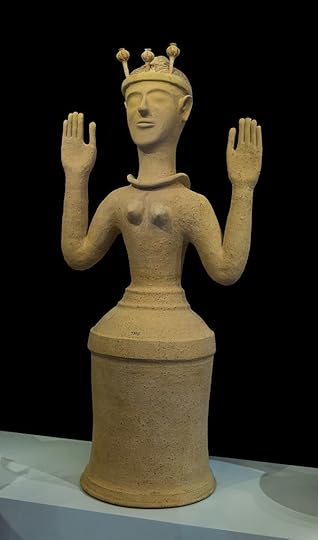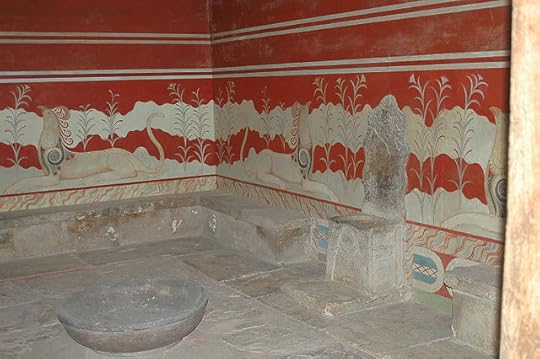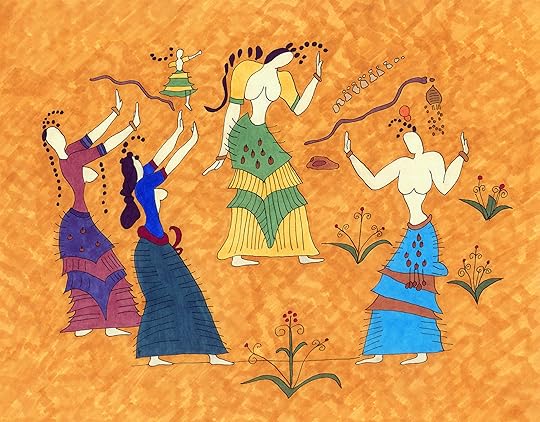Laura Perry's Blog, page 6
February 13, 2018
Modern Minoan Paganism: Resources
 I regularly get messages asking me for resources about Modern Minoan Paganism. I thought I'd gather everything together for you in one place.First of all, there's my Facebook group Ariadne's Tribe. That's where it all started, with this lovely group of people working together to build a Minoan spiritual path in the modern world. In addition to the discussion, we have a Files section full of book and website lists, articles, and even some stories our members have written.I have a blog focusing on Modern Minoan Paganism over at Witches & Pagans/PaganSquare. I post regularly about ancient Minoan culture and how we're putting those bits and pieces together in relationship with the gods and goddesses to make a practice that's relevant for Pagans today.I also have a Modern Minoan Paganism blog series over at The Pagan and the Pen. I'm no longer posting over there (too many irons in the fire) but that column will remain available for you as a resource indefinitely.I've written a bunch of Minoan-themed books, including fun stuff like a Minoan coloring book.I also teach two online courses about Modern Minoan Paganism, one of which starts up again in just a couple of weeks. These courses are designed to help you develop your own unique relationship with the Minoan gods and goddesses.And just to be clear, Modern Minoan Paganism is a welcoming path, happily open to people of any race, ethnicity, gender or gender identity, sexual orientation, age, ability level, disability, geographic location, language, education, or socio-economic status. We're all in this together.In the name of the bee,And of the butterfly,And of the breeze, amen!
I regularly get messages asking me for resources about Modern Minoan Paganism. I thought I'd gather everything together for you in one place.First of all, there's my Facebook group Ariadne's Tribe. That's where it all started, with this lovely group of people working together to build a Minoan spiritual path in the modern world. In addition to the discussion, we have a Files section full of book and website lists, articles, and even some stories our members have written.I have a blog focusing on Modern Minoan Paganism over at Witches & Pagans/PaganSquare. I post regularly about ancient Minoan culture and how we're putting those bits and pieces together in relationship with the gods and goddesses to make a practice that's relevant for Pagans today.I also have a Modern Minoan Paganism blog series over at The Pagan and the Pen. I'm no longer posting over there (too many irons in the fire) but that column will remain available for you as a resource indefinitely.I've written a bunch of Minoan-themed books, including fun stuff like a Minoan coloring book.I also teach two online courses about Modern Minoan Paganism, one of which starts up again in just a couple of weeks. These courses are designed to help you develop your own unique relationship with the Minoan gods and goddesses.And just to be clear, Modern Minoan Paganism is a welcoming path, happily open to people of any race, ethnicity, gender or gender identity, sexual orientation, age, ability level, disability, geographic location, language, education, or socio-economic status. We're all in this together.In the name of the bee,And of the butterfly,And of the breeze, amen!
Published on February 13, 2018 06:17
February 6, 2018
Minoan Bell Jar Goddesses: All the funny hats
 The Poppy Goddess is the most famous of the Minoan bell jar goddess figurines. But did you know that there are actually dozens of these, each one with a different headdress? I've explored their symbolism and meaning in today's Minoan Path blog post:Minoan Bell Jar Goddesses: All the funny hatsTo join the discussion about Modern Minoan Paganism and ancient Minoan civilization, head on over to our welcoming group at Ariadne's Tribe on Facebook.In the name of the bee,And of the butterfly,And of the breeze, amen.
The Poppy Goddess is the most famous of the Minoan bell jar goddess figurines. But did you know that there are actually dozens of these, each one with a different headdress? I've explored their symbolism and meaning in today's Minoan Path blog post:Minoan Bell Jar Goddesses: All the funny hatsTo join the discussion about Modern Minoan Paganism and ancient Minoan civilization, head on over to our welcoming group at Ariadne's Tribe on Facebook.In the name of the bee,And of the butterfly,And of the breeze, amen.
Published on February 06, 2018 05:27
January 30, 2018
Pagan Radio: Have a listen
 There's a lot of good Pagan music out there, and a lot of interesting people in the Pagan community. But where do you go to find them? The dark depths of YouTube? An endless Google search?Pagan radio stations! Yes, there is such a thing - several of them, in fact. I encourage you to listen and support them, and of course to buy the musical artists' music via the radio stations' links, on Bandcamp, and wherever else it may be legally available. So here you go:The Cauldron - Live radio, featured artists, operated by a Pagan non-profit organizationSacred Grove Radio - Live Pagan music, weekly top 10 by listener voteUnited Pagan Radio - Live Pagan talk radio, interviews, meditations, WUPR Pagan Music AwardsThere are also lots of Pagan radio shows and podcasts on BlogTalkRadio so it's worth a quick search there to find shows with topics that are right up your alley.Happy listening!
There's a lot of good Pagan music out there, and a lot of interesting people in the Pagan community. But where do you go to find them? The dark depths of YouTube? An endless Google search?Pagan radio stations! Yes, there is such a thing - several of them, in fact. I encourage you to listen and support them, and of course to buy the musical artists' music via the radio stations' links, on Bandcamp, and wherever else it may be legally available. So here you go:The Cauldron - Live radio, featured artists, operated by a Pagan non-profit organizationSacred Grove Radio - Live Pagan music, weekly top 10 by listener voteUnited Pagan Radio - Live Pagan talk radio, interviews, meditations, WUPR Pagan Music AwardsThere are also lots of Pagan radio shows and podcasts on BlogTalkRadio so it's worth a quick search there to find shows with topics that are right up your alley.Happy listening!
Published on January 30, 2018 05:53
January 9, 2018
Does Aphrodite have Minoan connections?
 Aphrodite was born from the sea-foam off the coast of Cyprus, an island with intimate ties to the Minoans of Bronze Age Crete. What might this lovely goddess have to do with the Minoans? Let's find out.Does Aphrodite have Minoan connections?In the name of the bee,And of the butterfly,And of the breeze, amen.
Aphrodite was born from the sea-foam off the coast of Cyprus, an island with intimate ties to the Minoans of Bronze Age Crete. What might this lovely goddess have to do with the Minoans? Let's find out.Does Aphrodite have Minoan connections?In the name of the bee,And of the butterfly,And of the breeze, amen.
Published on January 09, 2018 05:15
January 2, 2018
Not a resolution, just a meditation
 I've never really been into New Year's resolutions. To me, the energy this time of year is still too quiet, too dormant to get me motivated to make big life changes. I tend to make my resolutions around Spring Equinox instead (which happens to be the old European agricultural New Year) - when the seasons are growing and "springing" and I feel inspired to get moving.So what do I do in January? I pick a Saying of the Year.I know, it sounds dopey. But it works for me at this contemplative time of year, and then it keeps going all year long to help me find deeper meaning in life.I started this practice ages ago and it has been quietly, subtly life-changing. To be honest, I've never been very good at the sort of sit-down-every-day-in-silence kind of meditation. I'm a walking meditation kind of person. And my Saying of the Year is a long-term walking meditation, in a sense.How it works: Each year as the holidays approach, I put out the intention to receive the upcoming year's saying. It can be practically anything: a well-known proverb, a snippet of song lyrics, a quote I've read somewhere. Whatever it is, by the first of January it will have stuck in my head and made itself known (except for that one year when I asked my readers to help me choose).Then I let it do its thing for a whole year. Sometimes I sit quietly and contemplate its meaning. Sometimes it pops up in conversation or in a TV show I'm watching. Inevitably, it helps me see life in new and different ways, a deeper and broader view.Over the years I've had a wide variety of sayings. The first one was "All life is one life." The one my readers chose for me was "Wherever you go, there you are," which turned out to be pretty profound in spite of how trite it sounds.This year's saying popped into my head a few days ago and I haven't been able to shake it: Peace be with you.What a very appropriate thought to focus on for the next twelve months, considering what the world looks like right now. So I'll be walking with this saying, and sitting with it, and contemplating it. I'll enter into and find out what peace feels like, what it really is, what it means to wish it for others. I'm sure I'll be surprised at all the angles I find, all the experiences I have. And as always, I'll be thankful I went to the effort.Will you choose a saying to contemplate for the upcoming year?Peace be with you.In the name of the bee,And of the butterfly,And of the breeze, amen.
I've never really been into New Year's resolutions. To me, the energy this time of year is still too quiet, too dormant to get me motivated to make big life changes. I tend to make my resolutions around Spring Equinox instead (which happens to be the old European agricultural New Year) - when the seasons are growing and "springing" and I feel inspired to get moving.So what do I do in January? I pick a Saying of the Year.I know, it sounds dopey. But it works for me at this contemplative time of year, and then it keeps going all year long to help me find deeper meaning in life.I started this practice ages ago and it has been quietly, subtly life-changing. To be honest, I've never been very good at the sort of sit-down-every-day-in-silence kind of meditation. I'm a walking meditation kind of person. And my Saying of the Year is a long-term walking meditation, in a sense.How it works: Each year as the holidays approach, I put out the intention to receive the upcoming year's saying. It can be practically anything: a well-known proverb, a snippet of song lyrics, a quote I've read somewhere. Whatever it is, by the first of January it will have stuck in my head and made itself known (except for that one year when I asked my readers to help me choose).Then I let it do its thing for a whole year. Sometimes I sit quietly and contemplate its meaning. Sometimes it pops up in conversation or in a TV show I'm watching. Inevitably, it helps me see life in new and different ways, a deeper and broader view.Over the years I've had a wide variety of sayings. The first one was "All life is one life." The one my readers chose for me was "Wherever you go, there you are," which turned out to be pretty profound in spite of how trite it sounds.This year's saying popped into my head a few days ago and I haven't been able to shake it: Peace be with you.What a very appropriate thought to focus on for the next twelve months, considering what the world looks like right now. So I'll be walking with this saying, and sitting with it, and contemplating it. I'll enter into and find out what peace feels like, what it really is, what it means to wish it for others. I'm sure I'll be surprised at all the angles I find, all the experiences I have. And as always, I'll be thankful I went to the effort.Will you choose a saying to contemplate for the upcoming year?Peace be with you.In the name of the bee,And of the butterfly,And of the breeze, amen.
Published on January 02, 2018 04:55
December 26, 2017
Looking Back along the Minoan Path
 I've been writing the Minoan Path blog over at Witches & Pagans/PaganSquare for three and a half years now. As another year ends, I decided to have a look back and see which of my blog posts were the most popular. I was surprised to discover which ones people have read the most. Definitely not what I expected.Looking Back along the Minoan PathTo join the conversation about Modern Minoan Paganism and ancient Minoan civilization, head on over to our welcoming community at Ariadne's Tribe on Facebook.In the name of the bee,And of the butterfly,And of the breeze, amen.
I've been writing the Minoan Path blog over at Witches & Pagans/PaganSquare for three and a half years now. As another year ends, I decided to have a look back and see which of my blog posts were the most popular. I was surprised to discover which ones people have read the most. Definitely not what I expected.Looking Back along the Minoan PathTo join the conversation about Modern Minoan Paganism and ancient Minoan civilization, head on over to our welcoming community at Ariadne's Tribe on Facebook.In the name of the bee,And of the butterfly,And of the breeze, amen.
Published on December 26, 2017 05:07
December 19, 2017
The Tarot Tradition: Two Big Questions
 Since I've created a Tarot deck, a lot of people ask me questions about Tarot, everything from the history (which I usually have to look up to give accurate answers) to Tarot's connections with various kinds of spirituality. One question that I've gotten over and over again in various forms is this: Does Tarot belong to a particular spiritual tradition?The short answer is no.Now for the longer answer.The beginnings of Tarot are shrouded in mystery (or, more accurately, in a lack of historical records). But the cards have been used for both fortune telling and meditation for centuries, by a wide variety of people from different backgrounds. Tarot jumped in popularity in the early 20th century with the publication of the Rider-Waite-Smith deck and since then, it has continued to grow, with more and more people finding meaning through the cards.What kinds of people use Tarot cards? Liberal Christians. Pagans of all flavors. Ceremonial magicians. Jews who are interested in mysticism. People who don't use any kind of spiritual or religious label. Transpersonal psychologists and some Jungian psychologists use Tarot cards as a tool for exploration and insight in their counseling sessions. That's quite a wide variety of people, isn't it?How is it possible for all these different kinds of people to use Tarot? Because Tarot cards, in whatever form you prefer (there are hundreds of different decks now) are a self-contained system. I suppose you could classify them as occult, but really, they don't belong to any particular spiritual tradition. They are their own thing and can be used as a helpful tool by people from a wide variety of backgrounds and perspectives. It's especially helpful that we now have so many different decks to choose from, so each person has a good chance of being able to find exactly the symbol set that works for them.Ultimately, this is what Tarot is: a symbol set that we use as a tool for personal transformation and enlightenment.The second most common question I'm asked is where does the information in a Tarot reading come from?The short answer to this one is: wherever you think it comes from. In other words, we can't really say for certain, but there are a lot of opinions (aren't there always?). Some possibilities: your own subconscious, your higher self, your spirit guides, the divine, any combination of the above.Each person's opinion will depend on their own worldview, and that's just fine. The important thing is that Tarot cards work as a functional tool for helping us to gain insight into our lives. We can use them to make ourselves better people, to find greater satisfaction in life, to learn and grow and ultimately, to make the world a better place.I bid you peace.
Since I've created a Tarot deck, a lot of people ask me questions about Tarot, everything from the history (which I usually have to look up to give accurate answers) to Tarot's connections with various kinds of spirituality. One question that I've gotten over and over again in various forms is this: Does Tarot belong to a particular spiritual tradition?The short answer is no.Now for the longer answer.The beginnings of Tarot are shrouded in mystery (or, more accurately, in a lack of historical records). But the cards have been used for both fortune telling and meditation for centuries, by a wide variety of people from different backgrounds. Tarot jumped in popularity in the early 20th century with the publication of the Rider-Waite-Smith deck and since then, it has continued to grow, with more and more people finding meaning through the cards.What kinds of people use Tarot cards? Liberal Christians. Pagans of all flavors. Ceremonial magicians. Jews who are interested in mysticism. People who don't use any kind of spiritual or religious label. Transpersonal psychologists and some Jungian psychologists use Tarot cards as a tool for exploration and insight in their counseling sessions. That's quite a wide variety of people, isn't it?How is it possible for all these different kinds of people to use Tarot? Because Tarot cards, in whatever form you prefer (there are hundreds of different decks now) are a self-contained system. I suppose you could classify them as occult, but really, they don't belong to any particular spiritual tradition. They are their own thing and can be used as a helpful tool by people from a wide variety of backgrounds and perspectives. It's especially helpful that we now have so many different decks to choose from, so each person has a good chance of being able to find exactly the symbol set that works for them.Ultimately, this is what Tarot is: a symbol set that we use as a tool for personal transformation and enlightenment.The second most common question I'm asked is where does the information in a Tarot reading come from?The short answer to this one is: wherever you think it comes from. In other words, we can't really say for certain, but there are a lot of opinions (aren't there always?). Some possibilities: your own subconscious, your higher self, your spirit guides, the divine, any combination of the above.Each person's opinion will depend on their own worldview, and that's just fine. The important thing is that Tarot cards work as a functional tool for helping us to gain insight into our lives. We can use them to make ourselves better people, to find greater satisfaction in life, to learn and grow and ultimately, to make the world a better place.I bid you peace.
Published on December 19, 2017 04:50
December 12, 2017
Sacred Guardians: A Minoan-Themed Protection Spell
 Today on the Minoan Path blog, I'm sharing a protection spell from the new second edition of Ancient Spellcraft. The ritual has a Minoan theme and calls on the griffins, the powerful mythological companions of the sun goddess Therasia:Sacred Guardians: A Minoan-Themed Protection SpellIf you'd like to join the conversation about ancient Minoan culture and Modern Minoan Paganism, head on over to our welcoming community at Ariadne's Tribe on Facebook.In the name of the bee,And of the butterfly,And of the breeze, amen.
Today on the Minoan Path blog, I'm sharing a protection spell from the new second edition of Ancient Spellcraft. The ritual has a Minoan theme and calls on the griffins, the powerful mythological companions of the sun goddess Therasia:Sacred Guardians: A Minoan-Themed Protection SpellIf you'd like to join the conversation about ancient Minoan culture and Modern Minoan Paganism, head on over to our welcoming community at Ariadne's Tribe on Facebook.In the name of the bee,And of the butterfly,And of the breeze, amen.
Published on December 12, 2017 07:06
December 5, 2017
The Melissae: A Bit of Minoan Honey
 You may not have heard of the Melissae; they're among the less-well-known gods and goddesses from the Minoan pantheon. Today on the Minoan Path blog, I'm sharing what we know about them, both from ancient sources and from shared numinous experiences among modern Pagans:The Melissae: A Bit of Minoan HoneyTo join the discussion about Modern Minoan Paganism and ancient Minoan spirituality and culture, head on over to our welcoming community at Ariadne's Tribe on Facebook.In the name of the bee,And of the butterfly,And of the breeze, amen.
You may not have heard of the Melissae; they're among the less-well-known gods and goddesses from the Minoan pantheon. Today on the Minoan Path blog, I'm sharing what we know about them, both from ancient sources and from shared numinous experiences among modern Pagans:The Melissae: A Bit of Minoan HoneyTo join the discussion about Modern Minoan Paganism and ancient Minoan spirituality and culture, head on over to our welcoming community at Ariadne's Tribe on Facebook.In the name of the bee,And of the butterfly,And of the breeze, amen.
Published on December 05, 2017 07:24
November 28, 2017
By Land, Sea, and Sky: A Minoan ritual framework
 Every spiritual tradition has a standard framework for rituals and ceremonies. For instance, you're probably familiar with the Wiccan concept of casting a circle, calling the quarters, and invoking the deities. We don't know for sure what the ancient Minoans did, but we can make some educated guesses and build a modern method from there. I'm sharing my personal technique on today's Minoan Path blog:By Land, Sea, and Sky: A Minoan Ritual FrameworkIn the name of the bee,And of the butterfly,And of the breeze, amen!
Every spiritual tradition has a standard framework for rituals and ceremonies. For instance, you're probably familiar with the Wiccan concept of casting a circle, calling the quarters, and invoking the deities. We don't know for sure what the ancient Minoans did, but we can make some educated guesses and build a modern method from there. I'm sharing my personal technique on today's Minoan Path blog:By Land, Sea, and Sky: A Minoan Ritual FrameworkIn the name of the bee,And of the butterfly,And of the breeze, amen!
Published on November 28, 2017 10:05



